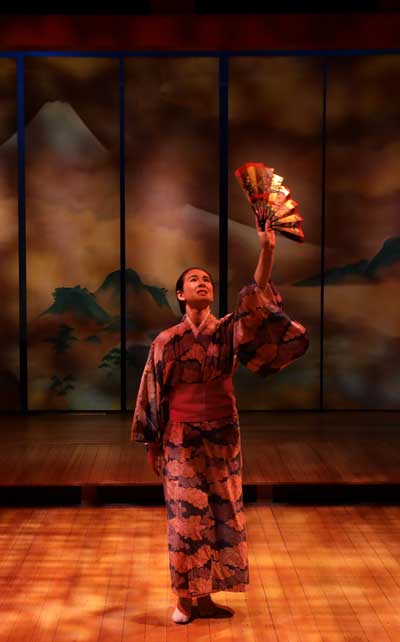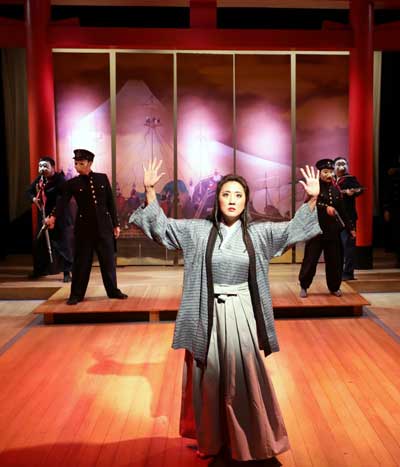Musical (1976)
Music and lyrics by Stephen Sondheim
Book by John Weidman
Directed by Spiro Veloudos
Music Direction by Jonathan Goldberg
Lyric Stage Company of Boston
Copley Square area, Boston
May 10 – June 16, 2019
Scenic Design: Janie E. Howland; Costume Design: Gail Astrid Buckley; Sound Design: Andrew Duncan Will; Lighting Design: Karen Perlow; Choreography: Micheline Wu; Mask Design: Brynna Bloomfield
With Lisa Yuen (Reciter, Shogun), Carl Hsu (Kayama), Sam Hamashima (Manjiro), Kai Chao (Commodore Perry, et al), Alexander Holden (Russian Admiral, et al), Elain Horn (Second Councilor, et al), Brandon Milardo (British Admiral, et al), Gary Thomas Ng (Shogun’s Mother, et al), Jeff Song (Lord Abe, et al), Karina Wen (First Observer, et al), Micheline Wu (Tamate, et al)

in “Pacific Overtures”
Photo: Mark S. Howard
Courtesy of Lyric Stage Company of Boston
Commodore Perry led a fleet to Japan in 1853 and made inroads there which had not been made for centuries. There was initially a lot of resistance by the traditional Japanese, but they did succumb. Other countries followed suit, and Japan’s connection to the world economy was assured.
This is one of Sondheim’s “idea” musicals, based generally on a concept or an historic event rather than on a focal group of characters. Though the story is less personal than in other of his musicals, the effect, particularly when done as well as this production is, can be strong.
The talented cast in this production morphs in one way or another to become a whole array of characters. Lisa Yuen, who plays the narrator or “reciter,” becomes at one point the Shogun. Gary Thomas Ng plays, to great effect, a series of old women, including the Shogun’s mother. And others wind up playing combinations of samurai, local officials, and various of the American (and other) invaders.
The staging and choreography of this work, which can be rendered chaotic under the wrong circumstances, is beautifully done. In the small performance space of The Lyric Stage a whole universe of encounters explodes, made highly effective by intelligent blocking of character movements overseen by director Spiro Veloudos, but, even more dramatically, by the expressive and energetically conceived choreography by Micheline Wu.
Music direction by Jonathan Goldberg is also brilliant. The execution of the non-trivial score is done precisely and eloquently, and carried off with impeccable precision by the vocalists and instrumentalists. There are some very complex multiple voice outings throughout and the cast carries them off with assurance and no indications of pitch vulnerability. Their approach is delicate and carefully interwoven, and Goldberg oversees the whole enterprise with sensitivity and expertise.

with Brandon Milardo, Jeff Song
Elaine Hom, Gary Ng
Photo: Mark S. Howard
Courtesy of Lyric Stage Company of Boston
The set by Janie E. Howland is simple but eloquent, with a wonderful painted screen across the back of the stage underneath a torii, a traditional Japanese orange-colored gateway. And vivid costumes by Gail Astrid Buckley, changed quite often, are effectively and intelligently designed. Noh-style masks designed by Brynna Bloomfield for the Western invaders are grotesque but effective.
Though the score does not contain any of the truly memorable Sondheim melodies and lyrics, there is a lot of appeal in it. The percussive sharpness with which music director Goldberg and the cast bang out some of the lines gives a sense of the earnest militancy with which the Japanese resist their intruders. Meanwhile, the famous Sondheim verbal patter employed effectively in different spots conveys the delicacy and pointed intelligence of those who felt their culture was being invaded.
Sondheim’s wonderful capacity for patter also gets put to good use in the British section of Please Hello, a fabulous takeoff on Gilbert and Sullivan’s I Am The Very Model of a Modern Major General from The Pirates of Penzance.
It is quite hard to produce this musical as beautifully as it is done here, and the director of this production and Lyric Stage artistic director Spiro Veloudos and his team are to be strongly credited for adding yet another strong interpretation of the Sondheim legacy to their roster.
– BADMan
Leave a Reply